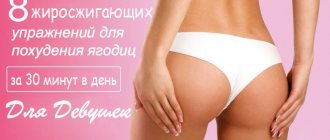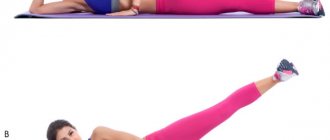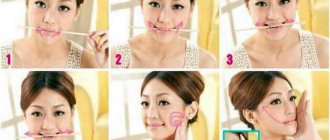How to remove ears on thighs at home. Exercises from the ears on the hips. Is it possible to remove ears on the thighs in a week?
The problem of excess weight, unfortunately, is known to almost all representatives of the fair sex. Depending on the constitution of the body and individual predisposition, excess fat can be located in completely different parts of our body, and accordingly, such fat will need to be dealt with in different ways. Today we will discuss such a well-known problem as “ears” on the sides and figure out how to get rid of it.
What are and why do “ears” appear on the thighs?
Unfortunately, “ears” on the hips are a very common problem for many women. Even girls with a graceful figure can encounter this phenomenon. Let's talk about what these very “ears” are.
IMPORTANT: The well-known “ears” are nothing more than excess fat deposits in the hip area. Most often, women with a pear-shaped figure face this problem. Women with this type of figure are characterized by a thin neck, very thin arms and shoulders, a slender waist and a very voluminous bottom, that is, hips and buttocks.
Now let's talk about the reasons why fat may accumulate in this area:
- Of course, the main reason for the appearance of ears on the thighs is a sedentary lifestyle and lack of regular physical activity. Any woman should understand that the absence of at least minimal physical activity in her life will easily lead to the appearance of such a problem.
- Eating fatty foods. Excessive consumption of fatty foods disrupts metabolic processes in the human body, and this in turn leads to obesity.
- Excessive love for sweets and baked goods. Any woman knows that consuming sugar, sweets, and cakes in large quantities will sooner or later lead to the problem of excess weight.
What do the ears on the thighs look like?
- Crackers, chips, and fast food also have a negative impact on human health and can cause such an unaesthetic phenomenon as “ears” on the hips.
- Individual predisposition. Sometimes “ears” on the hips appear not because of poor nutrition and a passive lifestyle, but because a woman at the genetic level tends to gain weight in her hips.
As you can see, the main reasons why women may experience excess fat deposits on their thighs are poor diet and lack of physical activity.
Diagnosis and treatment of noise in the head
When this unpleasant symptom appears, you should not waste time doing self-diagnosis, try to cope with it yourself, or hope that “it will pass.” The correct decision for the patient is to seek help from a specialist.
Diagnosis of diseases accompanied by noise in the head is carried out by doctors of various profiles - therapists, otolaryngologists, neurologists, psychotherapists/psychiatrists. But most often, patients with such a problem turn first to a neurologist.
First of all, the doctor’s task is to specify the noise, to understand what exactly the patient feels - a high-frequency squeak, ringing, buzzing, buzzing or hum, one- or two-sided, accompanied by pulsation or not; clarify the intensity of sensations and the symptoms that could accompany them. If the patient does not tell him himself, the doctor will ask leading questions about whether there is hearing loss, congestion in the ears, headache (usually occipital) pain, a tendency to increase or decrease blood pressure, find out what somatic diseases the person seeking his appointment suffers from. Human. Based on these data, the specialist will suggest what type of tinnitus he is dealing with - objective or subjective. Then he will conduct an objective examination - examine the organ of hearing and perform a number of tests necessary to make a diagnosis.
Shpidonov Gennady Stanislavovich
Neurologist
Rostov State Medical University (neurology)
10 years of experience
At the end of this diagnostic stage, the neurologist will make a preliminary diagnosis (or several putative diagnoses) and prescribe further examination to clarify it, in particular:
- general blood and urine analysis;
- blood biochemistry (lipidogram, coagulogram, ferritin);
- duplex or triplex scanning of neck vessels;
- MRI of the brain or cervical spine;
- consultation with an ENT doctor.
The scope of examinations is determined individually, depending on the specific clinical situation.
If a somatic doctor has not established the cause of noise in the head, he will assume the psychogenic nature of this condition and recommend that the patient consult a psychiatrist or psychotherapist. The specialist will have a targeted conversation with the patient, find out what complaints he has, focusing on feelings of anxiety or fear, decreased mood, especially in the morning, sleep disturbances, severe weakness, palpitations, sudden fluctuations in blood pressure, and will clarify whether this condition is permanent or temporary, not Is it related to stress? If a patient is suspected of neurosis, psychosomatic disorder or depression, the doctor will conduct a series of tests to clarify the diagnosis.
Only after the diagnosis has been established is it recommended to begin treatment for noise in the ear and head.
Medicines for noise in the head and ears
Conservative therapy often helps to cope with this symptom. Depending on the manifestation of which disease the noise is, the patient may be prescribed medications from the following groups:
- antibacterial, anti-inflammatory drugs (for infectious and inflammatory diseases of the ear);
- vascular drugs (improve blood circulation, nutrition of brain cells, dilate blood vessels);
- nootropics (improves metabolic processes in the cells of the nervous system);
- B vitamins (improve trophism of nervous tissue);
- trimetazidine (nourishes the heart muscle);
- iron supplements (if the noise is based on iron deficiency anemia);
- betahistine (for noise due to increased pressure in the cochlear labyrinth);
- antidepressants, anti-anxiety drugs, antipsychotics (if the pathology is psychogenic);
- sedatives, hypnotics – if the patient complains, it is not the inability to sleep;
- medications containing caffeine (for a tendency to low blood pressure, severe weakness and other symptoms of asthenia).
If the cause of the disease is cerumen, the doctor will wash it out of the ear and the noise will disappear.
Surgery
With confirmed damage to the autonomic nervous system, non-vibratory tinnitus can be eliminated by surgical intervention in the area of the nerves of the tympanic cavity or cervical sympathetic nodes.
Surgery on damaged structures of the tympanic cavity or cochlea will help get rid of objective noise.
Other treatment methods
As auxiliary methods of therapy, the patient may be prescribed:
- wearing a hearing aid, electrical stimulation of the auditory nerve (with decreased hearing acuity);
- physical therapy;
- massage;
- physiotherapy;
- psychotherapy.
How to quickly remove “ears” on your thighs: 20 minutes of exercises at home, tips, before and after photos
Taking care of yourself is always a huge and hard work. It will not be a secret to anyone that removing extra pounds is much more difficult than “earning” them, so many people put this matter off until later. It is also worth noting this trend - almost all women expect incredible results after just a few sessions, but this does not happen.
Despite the impossibility of getting rid of “lugs” on the thighs in 3-5 sessions, as is often promised, devoting only 20 minutes every day. of your precious time, after a month you can see the desired results.
So, we present to your attention a set of exercises that lasts 20 minutes. By diligently performing this set of exercises, you can get rid of this problem in the shortest possible time.
Let's start with lunges . This exercise perfectly works the muscles of the buttocks and legs, which is why it is so important to do them to eliminate “ears”:
- Starting position: we stand straight, straight, hands can be placed on the waist or left along the body, the soles of your legs should be under your hips, this is their location that will allow you to make the correct lunge
- Now we inhale and step forward with either foot, usually starting with the right foot. We go down. Be careful not to slouch, your back should be straight. As you lunge, try to distribute your weight evenly between your feet.
- If you started the exercise with your right leg, then when doing the exercise, your thigh should be parallel to the floor, while your left knee should just barely touch the floor
- Now a little about the rise. When you rise to the starting position, you need to do this by pushing off from the heel of the leg that is in front. Moreover, it is important to ensure that when lifting the body does not “stagger” or tilt in different directions.
- Lunge ready! This exercise should be performed on each leg. You should start with 3 sets of 10 exercises for each leg.
Lunges
Well, what sports don't involve squats? Squats are universal exercises that make almost all the muscles of the human body work:
- So, we must stand straight, place our legs a little wider than our shoulders, keep our back straight, and look in front of us. In principle, you can put your hands on your waist, put them behind your head, spreading your elbows to the side, or simply stretch them forward
- Next, we move our hips back a little and begin to squat
- The knees should not go beyond the feet, come together or spread apart.
- Remember, the lower you squat, the more effective your exercise will be. However, do not forget that it is better to do less, but with better quality, do not chase speed and number of times
- If you have a desired level that you want to go down to when doing a squat, then place some object at that level and squat until you touch it with your buttocks
- Your body weight should be on your heels during the exercise, otherwise you will not be able to work the muscles you need.
- You should start with 3 sets of 15 times
It’s impossible not to talk about leg swings, because such a seemingly simple exercise can save you from “ears” on your hips:
- Starting position: lie on the floor, on your side, while placing your arm bent at the elbow under your head, as if leaning on it, your back, as in the previous exercise, is straight
- Now we begin to slowly lift the leg that is on top. You can hold your leg a little at the top
- It is recommended to start with 3 sets of 20-25 times on each leg.
Do these simple exercises for just 20 minutes. every day, you can easily rid yourself of such an unpleasant phenomenon as “ears” on the thighs.
Swing your legs
Well, now some useful tips and secrets for you:
- To do exercises correctly, do them in front of a mirror so you can see your mistakes and correct them accordingly
- When doing lunges, control the force with which you go down, because “hitting” your knee on the floor can end in trouble for you in the form of injuries
- When standing up during lunges, under no circumstances use the leg behind you, because in this case your efforts will not be crowned with success.
- When doing squats, do not rush; superficial pseudo-squats do not work any muscles.
- Do not do any exercise without warming up, as this can lead to serious injury.
Prevention of pulsating noise in the head
The noise that occurs in the pulse rhythm is characteristic of vascular pathology of the brain. It can be prevented by a person’s attentive attitude to his health throughout his life - quitting smoking, regular exercise, adherence to a work and rest schedule, a nutritious, balanced diet, blood pressure control, timely medical examinations and treatment of vascular diseases that have arisen in the early stages. If these diseases already exist, following the recommendations described above will help reduce the intensity of the hum, alleviate it, which will improve the person’s quality of life.
If pulsating noise appears in the head only in certain situations (under stress, when working at the computer), its prevention will be to minimize exposure to situations that provoke deterioration of the condition.
What exercises and what machine can you use to remove the “ears” on your thighs in the gym?
If you have set a clear goal for yourself and decided to go to the gym, that’s great, because the gym has all the necessary equipment that will ease your “suffering” and speed up the process of getting rid of excess fat on your thighs.
So, the best simulators for our today's goal:
- As a warm-up, you can ride a “bicycle”. This simulator will perfectly warm up your muscles and set them up for further work. If you are a beginner “athlete”, then 3-5 minutes. will be more than enough. Although you need to choose the time and intensity of training based on your state of health and physical fitness
- Next, let's run on a treadmill. Interval running is best for weight loss. The essence of the exercise is that you need to alternate load modes. For example, 2 min. you run at a calm pace, then 1 minute. in fast, etc.
Exercises in the gym from ears on hips
- The lower block simulator will also come to your aid. With its help, you need to move your leg back or to the side. This exercise improves the shape and contour of the buttocks, as well as the hips.
- Arriving at the gym, you can do squats with an empty bar
- Exercise machines that help you get rid of “ears” are great, with the help of which you can bring and spread your hips, straighten and bend your legs. The leg press is also a good way to achieve our goal.
Here's our advice: since you're planning to work out in the gym, don't spare a little money and use the help of a trainer. It is not necessary to work with a trainer for 2-3 months; even a few lessons will be enough for you to understand the specifics of each exercise and learn how to perform them correctly.
- Squats and running are the best exercises for burning extra calories and, accordingly, fat.
- It is best to squat “deeply”
- It is best to run in different modes, alternating slow running (fast step) with fast running at acceleration
- Regular training means a lot. Remember, even such effective exercises as running and squats will not bring you the desired result if you do them once a week
Nutrition, diet to remove “ears” on the hips: tips
Unfortunately, most girls and women do not fully understand the importance of proper nutrition, and this applies not only to the period of weight loss.
It is important to understand that no amount of physical activity or exercise will give you the desired result if you do not start eating right and sticking to a normal daily routine.
This, in fact, is what we will talk about now. As such, there is no diet to eliminate “ears”, because we cannot independently choose the area on our body (in our case, the thigh) from which fat would disappear. Likewise, our body is not able to get rid of fat in only one place we need. Despite this, there are general rules and recommendations that will help you improve your figure and lose weight:
- You need to eat often, but little by little. You should have at least 4, or even 5-6 meals a day, but you should eat much less than usual. Try to always eat at the same time, this way you will accustom your body to a routine.
- Forget about not eating after 18.00, 20.00, etc. The last meal should be 3 hours before bedtime
- Chew every bite of food thoroughly. This is very important, because poorly chewed food takes longer to be digested by our stomach and this can lead to problems with the gastrointestinal tract
- Avoid eating while watching TV, movies, reading books, etc. When eating, you should enjoy the process, because while watching TV your attention is occupied by something else and in practice we get the following picture: the plate is already empty, and you have the impression that you haven’t sat down to eat yet
- Stop drinking water, especially soda, and eliminate it from your diet altogether. And don't drink right after eating
- Eat the largest portion at lunch. Also, do not forget to eat heavily in the morning, because during this meal you store up energy for the whole day. In the evening you need to eat lighter foods
- Train yourself to cook one meal at a time. Of course, everyone depends on the possibilities and time, but it is better to eat freshly prepared food, and not one that is reheated 2-3 times
- Of course, you need to forget about crackers, chips, soda and other chemicals. Also eliminate the consumption of mayonnaise, ketchup and various sauces.
- Alcohol and smoking are incompatible with proper nutrition and a healthy lifestyle, so it’s time to get rid of them once and for all
- Of course, don't forget to be active. Sitting with your butt on the sofa is unlikely to get rid of “ears”, even if you are not on the strictest diet in the world
Food to remove ears
Well, and finally, a sample menu for 1 day:
- Breakfast. Oatmeal, buckwheat or millet porridge with water. For those who cannot eat such food at all, you can cook porridge with low-fat milk. At the same time, add some nuts or dried fruits (prunes, dried apricots) to the porridge; you can add a couple of pieces. raisins Those who like to eat sandwiches for breakfast, there is an excellent option for you - a piece of whole grain bread with lightly salted fish or boiled chicken fillet
- Dinner. Vegetable soup and a small portion of buckwheat with boiled chicken or rice with boiled fish. Vegetables
- Dinner. Boiled beef with vegetables (can be baked, steamed), baked mushrooms with low-fat sour cream or stewed vegetables with baked fish
- For snacks, you can use low-fat kefir, apples, dried fruits, biscuits, special breads - all this should be eaten in moderation. Don't turn a snack into a full meal
Remember, a good diet is one in which you never feel incredibly hungry. Wanting to eat to the point of nausea and feeling dizzy is a sure way to end up in a hospital bed, but you can’t lose weight or remove the “ears” from your thighs.
About nutrition
Nutrition to eliminate ears does not require significant exceptions from the diet. Here it is enough to give up sweets and preferably fried foods. During the day, you should eat according to the rules of proper nutrition - eat three meals a day (breakfast, lunch, dinner) and include two snacks, but not buns and sweet bars, but fruits, vegetables, and dairy products.
There is no need to give up sweets and fried foods - just drink tea with a sweetener, consume no more than 4 shares of dark chocolate a day, fry foods in a frying pan without adding oil. Such dietary actions are necessary to prevent the recruitment of new storage fat cells, which can significantly slow down the elimination of reserve reserves.
How to remove “ears” on the thighs with massage: tips, video
Most people treat massage as a way of getting pleasure, undeservedly forgetting about its healing properties. Despite this, a properly done massage can significantly improve a person’s health, as well as eliminate problems with excess weight.
Of course, doing a high-quality massage on your own is very difficult and not always possible, so it is best to take the help of a specialist.
To eliminate problem areas on the hips, it is best to go for the following massage:
- Honey
- Anti-cellulite
- Modeling
Ear massage
Let's see what each type of massage can “give” us:
- Let's start with a “sweet” massage. Honey massage is not only useful, but also incredibly pleasant. Honey used in this type of massage perfectly removes waste and various toxins from the body. Honey massage also improves blood circulation. Thanks to this effect on the skin, it becomes smoother, more elastic and even, and it is worth noting that cellulite disappears
- Anticellulite massage. During such a massage, fat cells are broken down and removed from the human body in a natural way. It is thanks to anti-cellulite massage that you can achieve a reduction in the volume of the hips and buttocks
- Modeling massage can also work wonders. As a rule, this technique is used to correct the contours of the figure. Regular modeling massage significantly improves lymph flow, and this in turn helps eliminate cellulite and “ears”
It is important to understand that massage is effective only in combination with other exercises and, of course, proper nutrition.
How long can it really take to remove the “ears” on the hips?
This question naturally concerns absolutely all girls and women who have decided to fight fat deposits in the hips. However, it is simply impossible to answer it unequivocally.
- The time you spend eliminating the “ears” depends on many factors. For example, the “neglect” of the problem, the methods that you will use to eliminate the problem and, of course, your predisposition to “breeches”
- Don’t expect that after the first lesson your fat deposits will begin to “melt”; be patient and remember how long you “hatched and ate” them. Surely not 1, not 2 or even 3 months
- Based on the individual characteristics of the body, each person will need a completely different amount of time to eliminate this problem. Someone may spend a year, someone six months, and someone may be lucky, and after 3 months he will be bragging about his magical results
- With regular training and proper nutrition, the first results will be visible within 1-2 months, so be patient and do not feel sorry for yourself
- Remember, any of your results, even minimal ones, is excellent, because this is the only way to achieve your goal, because lying on the sofa your “ears” will not go away
Liposuction of “ears” on the thighs: before and after photos
Liposuction of the “ears” on the thighs is a cosmetic operation that can be used to change the nature of fat deposits in the thigh area. You need to understand that this type of figure correction is a surgical intervention, and therefore has a number of indications and contraindications. Of course, there is only one indication for this operation – the presence of “ears” and the desire to get rid of them.
Before and after the procedure Before and after the procedure
Contraindications are a little more complicated; liposuction cannot be performed:
- For thyroid and hormonal disorders
- For diseases of the liver, kidneys, heart and other vital organs
- If you have cancer
- You should also refrain from liposuction during pregnancy and breastfeeding.
- Well, of course, during acute viral and infectious diseases
If you are healthy and there are no contraindications for surgery, go ahead, but you must understand that surgery is always a risk to your health, so weigh the pros and cons.
How to hide the “ears” on the hips with clothes?
If for some reason you cannot, or simply do not want to deal with this problem, then you can disguise it, and, of course, the right clothes will help you with this.
So, here are some tips with which you can visually reduce the “ears” or hide them altogether:
- Give preference to dark colors of clothing. This does not mean that you should wear only black, remember, there are brown, burgundy, dark green and a bunch of other beautiful colors of clothing
Choose long sweaters and dark colors
- Vertical and oblique stripes will also help you hide your flaw.
- If you are a lover of skirts, then give preference to the “sun” and “half-sun” styles.
Choose flared skirts
- Jeans fit straight silhouette
Jeans should be chosen with a straight silhouette
- Also give preference to things in which the entire emphasis is on the waist rather than the hips
- Long sweaters and loose-fitting tunics can also hide the “ears”
Here are some things you need to give up:
- Light, bright and catchy things
- Things with horizontal stripes
- Too tight things, especially if the problem is not only the “ears”, but also excess weight throughout the body
- Leggings and leggings will also unpleasantly surprise you
“Ears” on the thighs are a very unpleasant problem for many women, but this is by no means a death sentence. As you can see, there are a huge number of ways that can help you get rid of this problem, you just have to choose the one you like and be patient!
Classification of noise in the head and ears
Due to the variety of noise variants, they were classified - combined into groups, common according to the causes of occurrence or characteristics of the course of the disease.
EPFowler (1947) identified two types of tinnitus:
- objective, or vibrator (occurs as a result of vibrations of any parts of the body, exists in reality, can be recorded using a phonendoscope or the use of other diagnostic methods);
- subjective, or non-vibratory (felt by a person, but does not occur in reality, the source of the hum in real life is absent; it cannot be assessed from the outside; it is also called the term “tinnitus”).
In their practice, doctors use a classification of noise based on its cause and distinguish:
- noise of the external, middle ear;
- muscular;
- vascular;
- central;
- peripheral noise.
Shpidonov Gennady Stanislavovich
Neurologist
Rostov State Medical University (neurology)
10 years of experience
Depending on the quality characteristics, the following are distinguished:
- one-sided or two-sided;
- pulsating or monotonous;
- arising from time to time or present constantly;
- low-frequency hum or high-frequency squeak, ringing;
- barely noticeable or strong, intense noise.











